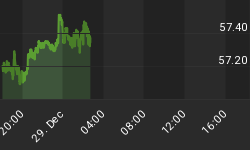For 13 weeks the "dumb money" has been on the wrong side of the trend and hopeful that the November, 2008 lows would hold. The "smart money" has not been bullish on the markets for about 20 weeks now. With the November, 2008 lows on the S&P500 convincingly behind us, the "dumb money" has turned bearish and the "smart money" is now the most bullish it has been in 30 weeks. These are bullish signals for equities.
The "Dumb Money" indicator is shown in figure 1. The "dumb money" looks for extremes in the data from 4 different groups of investors who historically have been wrong on the market: 1) Investor Intelligence; 2) Market Vane; 3) American Association of Individual Investors; and 4) the put call ratio.
Figure 1. The "Dumb Money"
The "smart money" indicator is a composite of the following data: 1) public to specialist short ratio; 2) specialist short to total short ratio; 3) SP100 option traders. The "Smart Money" indicator is shown in figure 2.
Figure 2. The "Smart Money"
Since the inception of this blog in November, 2008, I feel that the sentiment picture has helped us successfully navigate this market. For the most part, I have been bearish on equities or suggesting that strength be sold. For the last 16 weeks, the sentiment data has not been supportive of a tradeable, sustainable rally.
So here we are with the "smart money" bullish and the "dumb money" bearish. Beautiful! According to the back testing process, the optimal time to buy would be after this Friday's close.
In a follow up article (hopefully this week), I will put some context to these signals. They are by no means perfect or trading "holy grails". But we should pay attention to market sentiment as the current set of conditions can lead to accelerated gains as those on the sidelines chase prices higher.
Lastly, if equities do rally, I believe this will be a counter trend rally within an ongoing bear market. This will not be "the bottom", and it is my belief that "the bottom" will take time (i.e., many more months) to develop.
















